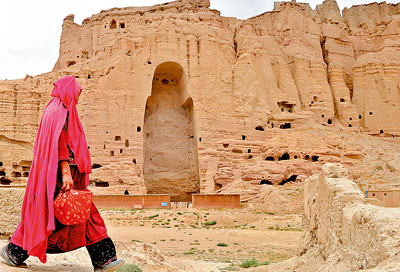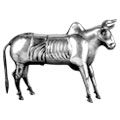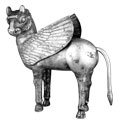The Destruction of the Bamiyan Buddha
 Click here to download this article.
Click here to download this article.
"The destruction of a piece of ancient art is a permanent loss for humanity which no power can replace it."
In 2001 the Taliban, because of its extreme religious bigotry, decided to wipe out all traces of cultural heritage in Afghanistan and in particular the world-famous statue known as the Bamiyan Buddha, the tallest carved sandstone statue of the ancient world. Their decision gave rise to profound concerns in the art circles of the world. Houshang Mahboubian decided to ignore all international political concerns and press ahead to save the statue. His efforts to save the Bamiyan Buddha were promptly reported in an article published in the UK daily newspaper The Times*.

Through the mediation of the Afghan embassy in London, Houshang succeeded in establishing contact with Mullah Mohammad Omar. On 5 March 2001 Houshang wrote a two-page letter to the Taliban leader. After a lengthy introduction he made a reference to the “allegations” circulating in the international media about the Taliban’s religious bigotry and their understanding of Islamic law, under the influence of which they were resolved to obliterate all traces of Afghan cultural heritage, which they classified as the “reproduction of human figures” in paintings or sculptures. The letter continues as follows:
It is not clear how true these rumours are, but the Taliban government should keep in mind that the creations of the artists of each country do not belong to the ruling group or government of the day to modify them as they wish and according to their own personal beliefs. The creations of the artists belong to the civilisations of the world. The destruction and eradication of such art, based on personal taste or desire, is an inconsiderate and unforgivable act and the damage resulting from this destruction of international cultural legacy is irreparable.
The ancient country of Afghanistan has contributed much to the art of the world. Your beautiful ancient works of art, which are spread around Afghanistan, in Kabul Museum and art museums throughout the world, are outstanding examples of the extensive talents of Afghan artists and your ancestors during the six-thousand years of art history in your country. This should be a source of pride for your society. It is your duty to preserve and guard such glories for the present generation and those to come.
The unique Buddhas of Bamiyan, which are prominent examples of art objects of your ancestors, were created centuries before Islam and were respected by the same ancestors. Today the thoughts and philosophies of Buddha are respected by billions of people who live in the countries around you. Is the disrespect and destruction of the manifestation of a person in whom a group of people (whose numbers are larger than those of Muslims) believe, and the creation of an ideological clash between them and the Muslims a correct and thoughtful course of action?
Because of all these reasons I beg of you to first reconsider and order the Taliban forces to refrain from the destruction of, and further damage to, these objects. Second, please choose to preserve for the present generation, and generations to come, these artistic treasures that are the pride of past generations of artists. Third, if none of these reasons are acceptable to the heads of the Taliban government, at least agree to have these objects sold.
On 2nd March 2001 a proposal was sent to you through the Embassy of Afghanistan in London, which you have no doubt received. I hereby repeat again that I am ready to buy the large, 175-foot-high Buddha of Bamiyan for $5 million and remove it from Afghanistan at my own expense. The detachment and transport of a statue of such a great dimensions from the high altitude of the rocky mountains of Afghanistan are a very difficult and expensive task. I have undertaken discussions with the international firm of John McCarthy Associate, who have huge helicopters and the necessary technology for such operations, and they have announced their readiness for such a project.
When negotiations with the Taliban government of Afghanistan were under way, Houshang Mahboubian contacted the United Nations Educational, Scientific and Cultural Organization (UNESCO) to obtain their official approval for the purchase and transfer of the Bamiyan Buddha statue out of Afghanistan. Unfortunately however, UNESCO was against Mahboubian’s proposal and informed him that any attempt in the direction is considered criminal according to the UNESCO Convention of 1970. Subsequently, due to the delayed communication, the bureaucracy and a breakdown in the line of the negotiations with the Taliban, Afghanistan Taliban muslims destroying bamiyan buddhas statues the Taliban went ahead and destroyed the statue using dynamite.
*Hussain, Zahid and Stephen Farrell, “Taleban Smashes Statues of ‘Infidel Buddha’”. The Times (5 March 2001), page 15.





